First Drive: 2017 Jaguar XE (Prototype)
#1

Gallery:
http://www.autoblog.com/photos/2017-...e-first-drive/
Engine: Supercharged 3.0L V6
Power: 340 HP / 332 LB-FT
Transmission: 8-Speed Auto
0-60 Time: 4.9 Seconds
Top Speed: 155 MPH (limited)
Drivetrain: Rear-Wheel Drive
Engine Placement: Front
Curb Weight: 3,670 LBS (est)
Seating: 2+3
Cargo: 16 CU-FT
MPG: 34.9 MPG (EU, Combined)
Warranty: 4 Years / 50,000 Miles
Power: 340 HP / 332 LB-FT
Transmission: 8-Speed Auto
0-60 Time: 4.9 Seconds
Top Speed: 155 MPH (limited)
Drivetrain: Rear-Wheel Drive
Engine Placement: Front
Curb Weight: 3,670 LBS (est)
Seating: 2+3
Cargo: 16 CU-FT
MPG: 34.9 MPG (EU, Combined)
Warranty: 4 Years / 50,000 Miles
For the first time in decades, the prize for the best-driving compact luxury sport sedan is very much up for grabs.
BMW's 3 Series, the segment's longstanding archetype, has grown a bit soft, distant and pricy. Its Japanese rival from Infiniti, the Q50, lost the plot thanks to its video game steering and dated powerplant. The Audi A4 is due for replacement and the fantastic Mercedes-Benz C-Class skews luxury over sport. The Cadillac ATS? With an excellent chassis hobbled by middling powertrains and the devil's own infotainment system, it isn't selling. Unlikely as it sounds, the Lexus IS is probably the segment's best driver, but you've got to learn to love those turn-to-stone looks.
So, where's a segment malcontent to look? Provided he or she is patient enough to wait for this car's spring 2016 arrival, allow us to recommend the 2017 Jaguar XE.
Let's be honest. Jaguar really needed to come out with guns blazing. The last time the British brand battled in the compact premium sport sedan segment, its much-maligned X-Type slinked into the underbrush, tail between its legs after just a single generation. While the X was in some ways a better car than history will begrudge it, there's no getting around that Jaguar brought a front-wheel-drive-based knife to a rear-wheel-drive gun fight.
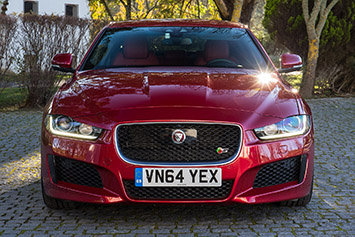
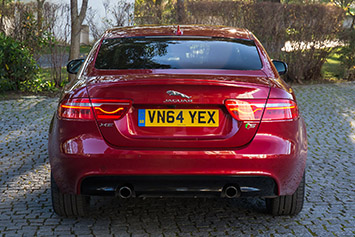
This new XE will need to be a very different kitty, and it is. Internally known as X760, Jag's latest rides atop an all-new aluminum-intensive modular architecture wearing a handsome mosaic of aluminum and steel body panels. While the XE's design has struck us as very familiar since it first bowed in September, it's an attractive shape. Its longish, 111.6-inch wheelbase and wheels-at-the-corner stance gives the design a planted look emphasized by its wide rectangular grille and prominent lower air intakes. Jaguar claims a super-slick .26 coefficient of drag, but that's the skinny-tired overseas base model that we'll never see – ours will likely ring up a few hundredths higher.
The aluminum body-in-white is itself an impressive piece of work, weighing just over 550 pounds. Vehicle engineering manager Jonathan Darlington says it's 20-percent stiffer torsionally than the XF, and "the lightest in the sector by far." What's more, the chassis incorporates liberal amounts of recycled aluminum (a claimed world first) and increased use of structural adhesives. We'll leave further details for How It's Made, but suffice it to say, an afternoon knifing a prototype XE through the wooded hills around Lisbon, Portugal, suggests Jaguar's engineers have done not only their homework, but perhaps that of their colleagues, as well.
At this point, we'd normally move on to discuss the XE's engine lineup, or its interior, but we're going to grab the wheel and talk about the steering, because it's one of this sedan's most impressive accomplishments.
We've grown incredibly tired of hearing automakers extolling the virtues of their new electrically assisted power steering systems. We know they save fuel and they allow for more adjustability through ones and zeroes, but in anything with any sporting pretenses, the vast majority of the time, we'd just prefer a decent hydraulic setup and bin the few percentage points of fuel savings in favor of actual road feel and progressive assistance.
Yet in 3.0-liter V6 S trim riding on 19-inch Dunlop SP Sport Maxx RT summer tires, this Jaguar's electric steering has the goods. It may be a shade light at parking-lot speeds, but when you're on the move, it's got positive on-center feel, with linear effort build and excellent accuracy. Most impressively, it's actually possible to tell what's going on with the front tires. The system even accounts for ambient temperatures, which can have an effect on tire pliancy and pressure, not to mention the dampers' kinematic properties. It's one of the best EPAS systems we've ever encountered, in any segment.
(A caveat: before declaring this the best steering in the class, we'll reserve final judgment until we drive a North American production-spec model on in-market tires. On our drive day, we also drove a 2.0-liter diesel XE on Pirelli Cinturato P7s, and not only was road feel not present as on the V6 S, there was also a lot more road noise.)
The double-wishbone front suspension and rear integral link arrangement on S models is augmented by standard Adaptive Dynamics, Jaguar-speak for electronically controlled dampers. The system makes the most of the rigid chassis and willing steering, allowing for both excellent wheel control and proper levels of road isolation when called for.
Jaguar tells us the goal in using an aluminum-intensive chassis wasn't just low overall weight, it was a strategy that allowed engineers to spend weight in the places that mattered – including a beefed-up suspension with tremendous lateral stiffness that helps create the sharp turn-in we spoke of.
That seems to be a tacit admission that despite its chassis, the XE isn't as feathery as one might hope. In fact, the base weight of the rear-drive XE S we tested is 3,670 pounds in German trim, suggesting it could be around 3,800 lbs or more by the time it's certified for NA roads – America's BMW 335i tips the scales at under 3,600 lbs. No matter. The Jag may not be the segment lightweight, but you won't notice from behind the wheel.
The XE's excellent transient response is surprisingly unaided by a mechanical limited-slip differential. Apparently Jaguar is keeping one on the shelf for the inevitable higher-performance variants, but it isn't really required – torque-vectoring by braking technology and that properly sorted suspension helps get the job done instead.
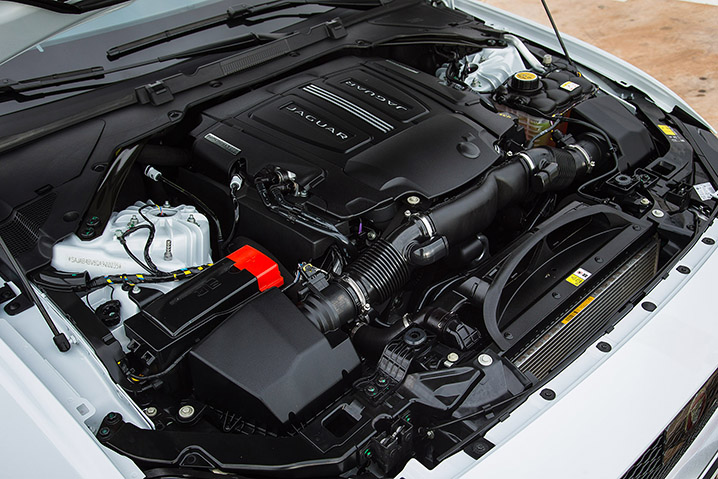
Much has been written about Jaguar's new Ingenium engine family, and indeed, it will shortly form the bedrock of Jaguar's powertrain lineup in North America, including a pretty swell 2.0-liter diesel four that will go on sale a few months after the 3.0. A gas version of the 2.0-liter will appear soon thereafter, along with a six-speed manual option. But the XE will first appear on our shores brandishing the well-known and well-liked 3.0-liter supercharged V6 we've sampled in everything from the F-Type to the XJ.
In XE guise, it delivers 340 horsepower at 6,500 rpm and 332 pound-feet of torque from 4,500 rpm. That means you'll have to keep the engine on boil to access its best bits, but it's an enjoyable endeavor aided by a nicely tuned version of ZF's ubiquitous eight-speed automatic (along with paddle shifters that actually respond when called upon). 0-60 time is given as 4.9 seconds, which would put it smack in the realm of cars like the 335i at the top of its class, and it feels every bit as rapid as that sounds (if not a few tenths quicker). Combined city/highway fuel economy is given as 34.9 miles per gallon on the relaxed EU test schedule.
Our prototype tester – one of the first dozen pilot cars built using production tooling – didn't have all of the proper interior fitments and textures, but its early build status wasn't immediately obvious. We could've done without the loud red and black leather in our cabin, but otherwise found a lot to like.
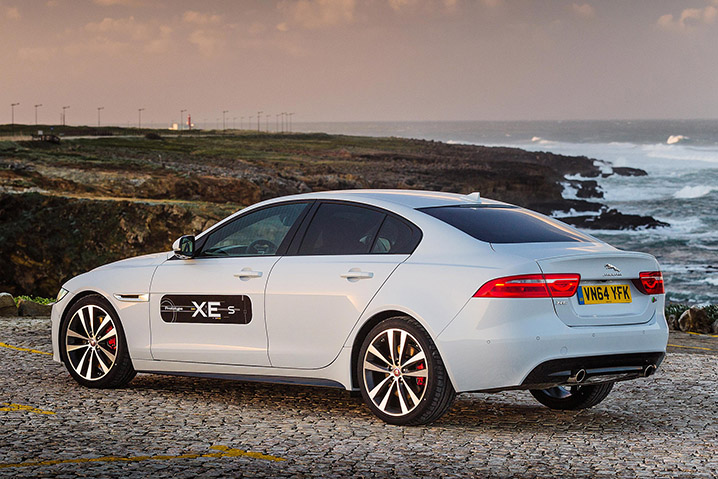
In particular, we love the way the XE adopts the 360-degree ring that integrates the dashboard, doors, and rear bulkhead, keeping the instrument panel low and contributing to an airier cabin that still feels wrapped around its occupants. The intersection between the dashboard and door panels is particularly interesting, and the small-diameter wheel felt great in hand, its compact airbag boss leaving plenty of room to see the gauges. The seats were also a high point – we put hundreds of miles on a pair of XFs in an afternoon and emerged no worse for the wear.
Cabin letdowns? Jaguar Land Rover's new InControl infotainment system. We had sampled it just a couple days earlier in Iceland at the Discovery Sport launch, and it's not as intuitive or snappy as others. The tablet-like pinch and swipe control scheme means you have to look at the screen more than rival systems, and it lacks the excellent handwriting recognition feature found on German models.
The only other major regret we have so far with the XE is that we're going to have to be patient for so long to get ours. While Europe and the rest of the world will start seeing the sedan on its streets soon, North American enthusiasts will have to sit on their hands. That's because Jaguar is insisting upon launching the range with available all-wheel drive (it learned the hard way with the XF and XJ that it's increasingly tough to sell rear-drive cars the upper half of the US, to say nothing of Canada).
Jaguar's last attempt at a compact sport sedan left the market bloodied, having made few defenders and even fewer friends. After a galvanizing day behind the wheel, we can't envision the XE suffering the same fate.
http://www.autoblog.com/2015/01/28/2...eview/#image-1
#2
This car really interests me, but it seems that once again a great car is let down by its infotainment system (Cadillac, are you listening?) At least by the time it hits our shores hopefully they will have worked the bugs out. By the time North America gets it, it will practically be a 2nd year model.
#3
Should be a nice buzz for Jaguar though I expect it may quickly fall out of the lime light if it becomes stale. Jaguar needs to make sure they are listening to consumers and adapting. I like this car. Now shove a V8 in it !!!!!!!!
#5

Gallery:
http://www.autoblog.com/photos/2017-...-second-drive/
Engine: SC 3.0L V6
Power: 340 HP / 332 LB-FT
Transmission: 8-Speed Automatic
0-60 Time: 4.9 Seconds
Top Speed: 155 MPH
Drivetrain: Rear-Wheel Drive
Engine Placement: Front
Seating: 2+3
Power: 340 HP / 332 LB-FT
Transmission: 8-Speed Automatic
0-60 Time: 4.9 Seconds
Top Speed: 155 MPH
Drivetrain: Rear-Wheel Drive
Engine Placement: Front
Seating: 2+3
You've seen this movie before. Topple the BMW 3 Series has gone more rounds than The Fast and The Furious and The Transporter combined. But like any good cinematic retread, this time it's different.
For starters, the latest installment is a zombie flick. Born from the ashes of Ford ownership and the failed X-Type, the 2017 Jaguar XE is coming to save us from the somnambulant, undead Bimmer. Think Army of Darkness with luxury sport sedans, and you'll understand what we're going for.
Okay, the plot is only based on a true story. The reality in the automotive world isn't as dramatic as most car journalists would like you to believe. But the XE is hugely important for Jaguar's desire to increase global production. You're looking at the future best-selling model. It's built on an all-new body structure that forms the basis for all the brand's upcoming sedans. The smallest, most affordable Jaguar also launches with a new engine family, built in a new factory in England.
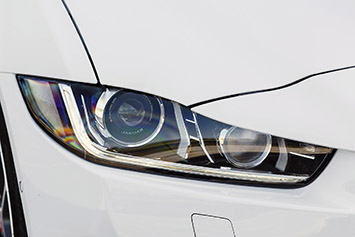

The XE arrives stateside in early 2016 with two available engines. A 2.0-liter diesel from the new Ingenium lineup is the entry-level model. Above that is the supercharged 3.0-liter V6 familiar to the Jaguar and Land Rover lineup. A turbo 2.0-liter gas engine will come in below the diesel at a later date, with an optional manual transmission. The XE versions on launch will offer rear- or all-wheel-drive. Pricing information is yet to be revealed. Until then, just assume the XE will mimic its competitors for price and content. We spent most of our time driving the 35t with R-Sport trim, but check back for a driving impression of the diesel in a few days.
As we reported in our prototype drive of the XE earlier this year, this car has incredible steering feel. It's the supernatural aid in the XE's monomyth if any film buffs are still paying attention. The electrically assisted system ranks in the hall of fame with the rack on the current Porsche 911 Carrera. Lightly weighted, the loads build up in the steering wheel like it's wired to strain gauges on the sidewall of the front tires.
It's not just good programming that makes the XE steer so well, although that's a big part. The rest comes from the chassis. Jaguar engineers claim the double wishbone front suspension uses lessons learned from the F-Type. The rear part of the car's quick responses comes from a multi-link setup Jag calls integrated link. A body 20-percent stiffer than the current XF also contributes to sharp reflexes. Three-quarters of the structure is made of aluminum, and the dashboard crossbeam uses magnesium. Still, we expect a loaded 35t to tip the scales close to 3800 pounds, close to the BMW 335i's weight.
If the XE isn't the featherweight of its class, though, you'd never know from behind the wheel. Outputs of 340 horsepower and 332 pound-feet of torque have a way of hiding mass. Paired to a ZF eight-speed, the XE 35t sprints to 60 in a claimed 4.9 seconds. Less brash than the exhaust note in the F-Type, the V6 still emits a medium pitch rasp that never fails to please. Supercharger whine is barely perceptible. Most of what you hear is just the sweet sounds of combustion.

Driving around Rioja, Spain's wine country and at the Circuito de Navarra, the XE's chassis and powertrain are in perfect harmony. Like other Jaguars, the ride is soft and compliant. It only hints at the car's abilities. We joked about the absurdity of driving the XE on the track - lapping sessions on press launches are as cliché as Nürburgring times - only to find out that the baby Jaguar can handle any road course abuse. What's most impressive is the car's balance. Find the limits and you'll see that the edge is like a gentle slope. Understeer is easily managed by the fade-free brakes. Jaguar engineers are so good at ride and handling tuning, we wonder if British bedtime stories are tales of force-displacement curves and spring-damper ratios.
An aside on one other absurdity: Jaguar's naming scheme. The descriptions: 35t, 20d, 25t (the designation for the 2.0-liter gas engine) relate only slighty to horsepower, displacement, or the vague notion of "virtual displacement" conjured up by evil German marketing executives. In any case, this system is no less crazy than numbers on the trunk of other cars. And they line up with the equivalent competition.
And speaking of badges, the XE sticks them on some handsome bodywork. The car shares common styling themes with the XF and XJ. The goal, said designer Wayne Burgess, was to unify the brand's look across the lineup. In front, the headlights carry the "J-blade" swooping line with the daytime running lamps. Close up, at the border of the headlights and front fender, the styling seems unified with the 3 Series. But the overall look is genuine Jaguar. And if you weren't sure, the name is spelled out on the trunklid below the leaping cat in homage to the E-Type. The rectangular tail lamps house another familiar shape with glowing brake lights that mimic the F-Type's.
Inside, the swooping dash borrows from the XJ with the arc continuing through to the door panels. In the center lies Jaguar's new infotainment system, known as InControl. The good news is that this is a vast improvement from Jaguar's current touchscreen. It's responsive, easy to use, and has hard buttons that shortcut to the main functions. The bad news is that this is still a touchscreen, so it's tough to do anything but basic tasks while driving. Below InControl is the rotary shift ****, with the Jaguar Drive Control settings in a row of buttons to the rear. The system alters the steering, throttle response, transmission setting, and if equipped, adjustable dampers between four settings. Switch from Normal to Dynamic mode and the gauges change their glow from blue to red. At night the ambient lighting shifts as well.

The cabin materials are impressive, with soft leather, a stitched dash, and real metal paddle shifters on the steering wheel. There are a couple of let-downs, like cheap plastic on the top of the steering column and a chintzy feel to the multifunction buttons on the wheel. Still, Jaguar did well to make this a first-class cabin. It doesn't top the materials in the Mercedes-Benz C-Class, but then again the C-Class doesn't drive as well as the XE.
Does the XE have what it takes to put the BMW out of its misery? With sales in the US almost a year away, we've only seen a preview of the XE-versus-the-world feature. But spoiler alert: we're pretty sure the good guy wins this one.
http://www.autoblog.com/2015/04/30/2...uar-xe-review/
Thread
Thread Starter
Forum
Replies
Last Post



